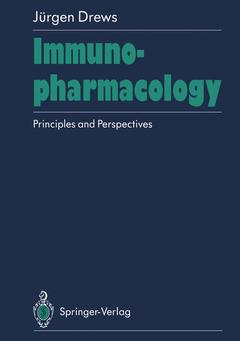Immunopharmacology, Softcover reprint of the original 1st ed. 1990 Principles and Perspectives
Langue : Anglais
Auteur : Drews Jürgen

Immunopharmacology is defined as that part of pharmacology that deals with drugs acting on the immune system and, in addition, with the pharmacological actions of substances derived from the immune system. In order to lend sharper definition to the term immunopharmacology the subject matter has been divided according to clinical and pragmatic criteria. The division into immunosubstituion, immunosuppression, antiallergic substances and immunostimulation gives the heterogeneous material a tighter structure than would any classification according to origin, chemical structure or mechanism of action.
1 Definition and History.- 2 The Immune System — A Short Introduction to its Structure and Function.- 2.1 The cells of the immune system.- 2.1.1 T- and B-lymphocytes.- 2.1.1.1 Lymphocyte receptors.- 2.1.1.2 Immunological memory.- 2.1.1.3 Generation of receptor diversity in lymphocytes.- 2.1.1.4 Effector functions of T-cells.- 2.1.1.5 Transplantation reactions and MHC antigens.- 2.1.2 Macrophages.- 2.1.3 Neutrophils.- 2.1.4 Eosinophilic granulocytes.- 2.1.5 Mast cells and basophils.- 2.1.6 NK- and K-cells.- 2.2 Humoral components of the immune system.- 2.2.1 The structure and function of antibodies.- 2.2.1.1 Antibody diversity.- 2.2.1.2 Physico-chemical aspects of antibody binding.- 2.2.2 Lymphokines and cytokines.- 2.2.2.1 Interferons (see also Chapter 6).- 2.2.2.2 The interleukin family.- 2.2.2.3 The tumour necrosis factor family.- 2.2.2.4 Chemotactic factor family or ‘small inducible gene’ family.- 2.2.2.5 The chromosome 5 linkage group.- 2.2.2.6 Individual cytokines with no close relatives.- 2.2.3 The complement system.- 2.3 Synopsis.- 3 Antibodies as Immunopharmacological Agents.- 3.1 Polyclonal animal immunoglobulins.- 3.1.1 Anti-lymphocyte (ALG) and anti-thymocyte (ATG) globulins.- 3.1.2 ATG/ALG can suppress transplantation immunity.- 3.1.3 ALG/ATG can facilitate hematopoietic recovery in patients with aplastic anemia.- 3.1.4 ALG/ATG can cause serum sickness.- 3.2 Polyclonal human immunoglobulins.- 3.2.1 Human IgG preparations.- 3.2.1.1 Standard ?-globulin (SGG).- 3.2.2 Intravenously applicable IgG preparations (IGIV).- 3.2.2.1 Enzymatically split immunoglobulin preparations.- 3.2.2.2 Chemically modified ?-globulins.- 3.2.2.3 Largely intact immunoglobulins.- 3.2.3 The subclass composition of IgG preparations.- 3.2.4 Contaminants of IgG preparations which can cause adverse reactions.- 3.3 Therapeutic applications of human immunoglobulins.- 3.3.1 Animal experiments with ?-globulins in infections.- 3.3.2 Clinical applications of human ?-globulins.- 3.3.2.1 Prophylaxis.- 3.3.2.2 Replacement of immunoglobulin.- 3.3.2.3 Therapy.- 3.3.2.4 Morbus hemolyticus neonatorum is largely prevented by anti-D IgG prophylaxis.- 3.3.2.4 IgG in the treatment of diseases caused by autoantibodies.- 3.4 Monoclonal antibodies.- 3.4.1 Methods of monoclonal antibody production.- 3.4.2 The use of monoclonal antibodies in neoplastic diseases.- 3.4.2.1 Tumour-associated antigens.- 3.4.2.2 Strategies for the use of antibodies in cancer treatment.- 3.4.2.2.1 In vivo use of unmodified antibodies.- 3.4.2.2.2 In vivo use of modified antibodies.- 3.4.2.2.3 In vitro use of unmodified or modified antibodies.- 3.4.2.3 Prospects of cancer therapy with monoclonal antibodies.- 3.4.3 Other therapeutic uses of monoclonal antibodies.- 4 Immunosuppression.- 4.1 What is an immunosuppressive?.- 4.1.1 Blocking the immune response.- 4.1.2 Strategies leading to the induction of tolerance.- 4.2 Azathioprine.- 4.2.1 Chemistry, history.- 4.2.2 Pharmacokinetics.- 4.2.3 Mechanism of action.- 4.2.4 Immunopharmacological effect of azathioprine.- 4.2.5 Clinical use.- 4.3 Glucocorticoids.- 4.3.1 Cellular mechanism of action.- 4.3.2 Pharmacological effects.- 4.3.2.1 Effect on the distribution of blood cells.- 4.3.2.2 Inhibition of lymphocyte activation.- 4.3.2.3 Lytic effects on lymphocytes.- 4.3.2.4 Phospholipase A2 inhibitors.- 4.4 Cyclosporin A.- 4.4.1 Chemistry.- 4.4.2 Immunosuppressive properties.- 4.4.3 Mechanism of action.- 4.4.4 Absorption, pharmacokinetics.- 4.4.5 Side effects.- 4.4.6 Clinical use.- 4.5 FK 506.- 4.5.1 Pharmacology.- 4.5.2 Toxicity.- 4.6 Orthoclone T3 (OKT3).- 4.6.1 Physical properties.- 4.6.2 Immunological actions.- 4.6.3 Therapeutic applications of OKT3.- 4.7 Immunotoxins.- 4.7.1 Mechanism of action.- 5 Substances with an Antiallergic Effect.- 5.1 Immediate-type hypersensitivity reactions.- 5.1.1 Histamine.- 5.1.2 Further primary and secondary mediators.- 5.1.3 IgE antibodies.- 5.1.3.1 Regulation of IgE synthesis in rodents (according to K. Ishizaka).- 5.1.3.2 Regulation of IgE synthesis (according to D. Katz).- 5.1.3.3 IgE regulation in human cell systems.- 5.1.3.4 Desensitization and IgE regulation.- 5.1.4 Degranulation of mast cells.- 5.1.4.1 Phospholipid metabolism.- 5.1.4.2 Cyclic nucleotides.- 5.1.4.3 Prostaglandins and leukotrienes.- 5.1.4.4 The biological role of prostaglandins and leukotrienes in immediate-type hypersensitivity.- 5.1.5 Antiallergic agents.- 5.1.5.1 Antihistamines.- 5.1.5.2 Cromolyn sodium.- 5.1.5.3 Ketotifen.- 5.1.5.4 Oxatomide.- 6 Immunostimulation.- 6.1 Possible therapeutic strategies.- 6.2 Endogenous substances.- 6.2.1 The role of gene cloning in the characterization and production of lymphokines and other endogenous proteins.- 6.2.2 Interferons.- 6.2.2.1 Definition and history.- 6.2.2.2 Classification.- 6.2.2.3 Properties.- 6.2.2.4 The interferon receptors.- 6.2.2.5 Biochemical and molecular changes induced by interferons.- 6.2.2.6 Physiological role of the interferons.- 6.2.2.7 Clinical uses of interferons.- 6.2.2.8 Synopsis, prospects.- 6.2.2.9 Interferon inducers.- 6.2.3 Interleukin 2.- 6.2.3.1 Definition and history.- 6.2.3.2 Properties.- 6.2.3.3 Mechanism of action.- 6.2.3.4 Changes in Il-2 production in vivo.- 6.2.3.5 Therapeutic uses of Il-2.- 6.2.4 Colony stimulating factors.- 6.2.4.1 GM-CSF.- 6.2.4.2 G-CSF.- 6.2.4.3 Interleukin 3.- 6.2.4.4 M-CSF.- 6.2.5 Thymic hormones.- 6.2.5.1 Definition and history.- 6.2.5.2 Thymosins and related peptides.- 6.2.5.3 Immunological effects of thymosin.- 6.2.5.4 Clinical findings with thymosin.- 6.2.5.5 Other thymic hormones.- 6.2.6 Transfer factor.- 6.2.7 Tuftsin.- 6.3 Substances of microbial origin.- 6.3.1 Patterns of macrophage activation.- 6.3.2 Corynebacterium parvum and BCG.- 6.3.3 Muramyl dipeptides.- 6.3.4 Beta 1,3-D-glucan.- 6.3.5 Coenzyme Q (ubiquinones).- 6.3.6 Bestatin.- 6.4 Synthetic substances.- 6.4.1 Levamisole.- 6.4.1.1 Pharmacokinetics.- 6.4.1.2 Mechanism of action.- 6.4.1.3 Immunopharmacological effects.- 6.4.1.4 Clinical use.- 6.4.1.5 Side effects.- 6.4.2 Cimetidine.- 6.4.2.1 Pharmacokinetics.- 6.4.2.2 Immunopharmacological effects.- 6.4.2.3 Clinical findings.- 6.4.2.4 Side effects.- 6.4.3 Isoprinosine.- 6.4.3.1 Pharmacokinetics.- 6.4.3.2 Clinical uses.- 6.4.3.3 Mechanism of action.- 6.4.3.4 Side effects.- 6.4.4 Other synthetic immunostimulants.- 7 Clinical Assessment and Perspectives.- 7.1 Immunosubstitution — antibodies.- 7.2 Immunosuppression.- 7.3 Antiallergic substances — suppression of the acute-type hypersensitivity reaction.- 7.4 Antiinflammatory substances.- 7.5 Immunostimulation — biological response modifiers.- General literature.- References.
Date de parution : 12-2011
Ouvrage de 355 p.
17x24.2 cm
Disponible chez l'éditeur (délai d'approvisionnement : 15 jours).
Prix indicatif 105,49 €
Ajouter au panierThèmes d’Immunopharmacology :
© 2024 LAVOISIER S.A.S.



